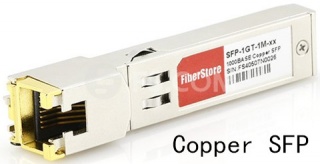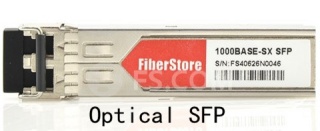Copper & Optical SFP Modules
srijeda , 25.05.2016.In order to maintain the configuration flexibility and establish connections that allow smooth data transfer from the source to the end point, SFP transceiver modules are utilized in the copper or optical Gigabit Ethernet (GbE) networks. SFP (Small Form-factor Pluggable) is a compact, hot-swappable, input/output device used in data communication and telecommunications networks. SFP interfaces between communication devices like switches, routers and fiber optic cables, performing optical and electrical signal conversion. There are many copper an optical SFP transceivers based on different GbE physical layers, such as Cisco 1000BASE-T SFP-GE-T and 1000BASE-SX SFP MGBSX1.
GbE Development
The initial standard for GbE was produced by the IEEE in June 1998 as IEEE 802.3z. Two designs were ratified in IEEE 802.3z to transmit signals over optical cables: the 1000BASE-SX uses short-wavelength laser (850nm) on multi-mode fiber (MMF), and the 1000BASE-LX uses long-wavelength laser (1310nm) on the standard single-mode fiber (SMF). At that time, transmitting 1000Mbps signals on the widely deployed Category 5 UTP was a significant challenge for silicon-chip designers. It requires tremendous signal processing to mitigate the channel impairments in copper wires such as ISI (intersymbol interference) introduced by limited channel bandwidth and signal crosstalks between pairs of copper wires. It was not until a year later that the 1000BASE-T standard (IEEE 802.3ab) was finished. To keep the cost of GbE low, the IEEE 802.3z committee very conservatively defined the transmission distance limit of 1000BASE-SX as 300m, and that of 1000BASE-LX as 5 km.
SFP Port Types
Specified by the Multisource Agreement (MSA), SFP, also known as a mini gigabit interface converter (GBIC), delivers the similar functions just as what a GBIC does, but designed with a much smaller size. As mentioned above, SFP transceiver has several interfaces which are standardized to work on SMFs and MMFs. Besides, SFP transceivers are also available with copper cable interfaces, like 1000BASE-T. This means that SFP module which is designed primarily for optical fiber communications can also communicate over unshielded twisted pair (UTP) cables. The image below shows different GbE SFP standards.
Copper SFP Modules
The development of copper technology in SFP modules is of great importance in enabling system designers to meet objectives while simplifying their inventory and reducing operating costs. These copper SFP transceivers scale Ethernet 10/100Mbps performance to 1000Mbps. Compared with 1Gbps, 1000BASE-T is 100 times as fast as the standard Ethernet. Additionally, the Full Duplex Repeaters (FDRs), when coupled with 1000BASE-T, offer an easy-to-manage, high-burst rate, and shared-media solution capable of supporting both end users and server farms. Popular copper SFP products, like Cisco SFP-GE-T, are used in Gigabit networks and they are fully compatible with 1000Base-T.
Optical SFP Modules
Both 1000BASE-SX and 1000BASE-LX are standardized for fiber optics. They share the 8B/10B 1000BASE-X PCS line coding. In addition to the transmission media, the only difference between 1000BASE-SX and 1000BASE-LX lies in the physical medium dependent (PMD) layer which defines the laser transmitter and photodetector. The interface between the physical medium attachment (PMA) and PMD layer is simply a serial interface. This made it easy to reuse all the designs between 1000BSAE-SX and 1000BASE-LX except the PMD transceiver.
Modern optical SFP modules support digital diagnostics monitoring (DDM) functions, also known as digital optical monitoring (DOM). This feature gives users the ability to monitor the real-time parameters of SFP, such as optical output power, optical input power, temperature, laser-bias current and transceiver supply voltage. The real-time diagnostic parameters can be monitored to alert the system when the transceiver’s specified operating limits are exceeded and compliance cannot be ensured. What’s more, the DDM function can be used to isolate the particular location of fault in fiber optic network system. Combining the DDM interface status flags, transceiver hard pins and diagnostic parametric monitor data the specific location and cause of a link failure can be pinpointed. Certainly, DDM function also has its role in failure prediction on fiber optic links, which is based on the transceiver parametric performance., including device faults and high error rate conditions.
SFP Module Applications
Apart from GbE, SFP modules can also support other communications standards, including synchronous optical networking (SONET)/synchronous digital hierarchy (SDH), and fiber channel. They allow the transport of fast Ethernet and GbE LAN packets over time-division-multiplexing-based WANs, as well as the transmission of E1/T1 streams over packet-switched networks.
SFP Purchasing Tips
When picking such a SFP module for your network, the first important factor to be considered is the price, especially for those small and medium-sized enterprises who have a tight budget. The other points go to the product compatibility, stability, and reliability. Otherwise, no matter how low the price is, it’s of no use.
Conclusion
Copper and optical SFP modules have proven themselves as the useful devices for the increased bandwidth requirements of users with each passing day. Fiberstore supplies a wide range of SFPs to support both copper and optical interfaces. They are fully compatible with such famous brands as Cisco, Juniper, D-Link (ie. DEM-311GT). Here just lists a few for your reference. For more information about SFP modules, you can visit Fiberstore directly.
Oznake: GbE, SFP, 1000BASE-T, SFP-GE-T, 1000BASE-SX, MGBSX1, DEM-311GT, 1000BASE-LX
komentiraj (0) * ispiši * #
1000BASE-X SFP Modules Overview
ponedjeljak , 28.03.2016.A continuous stream of manufacturing process improvements and product innovations has given fiber optical system several advantages, like longer distance reach, larger data-carrying capacity, greater bandwidth and lower power consumption. Among these fiber optical product innovations, hot-pluggable transceiver modules should come to the central point with their unique designs. They have been constantly designed, and finally been reinvented as hot-pluggable modules along with the optical technological advances. These small, hot-pluggable serve as the key components in accommodating the demands of higher port density and more networking flexibility.
Transceiver modules come into various types: SFP (small form-factor pluggable), SFP+ (small form-factor pluggable plus), QSFP+ (quad small form-factor pluggable plus), etc. This article mainly introduces SFP transceiver modules which are widely applied in Gigabit Ethernet (GbE) applications, with the focus on several 1000BASE-X interface types, including 1000BASE-SX, 1000BASE-LX, 1000BASE-EX, and 1000BASE-BX10-D/U.
Features and Benefits
1000BASE-X SFP modules provide a wide range of form factor options for enterprise and service provider needs. They are designed with the following features and benefits:
Hot swappable to maximize uptime and simplify serviceability;
Flexibility of media and interface choice on a port-by-port basis, so you can “pay as you populate”;
Sophisticated design for enhanced reliability;
Supports digital optical monitoring (DOM) function;
1000BASE-X SFP Interface Types
1000BASE-SX SFP
1000BASE-SX SFP, compatible with the IEEE 802.3z 1000BASE-SX standard, operates on legacy 50Ľm multi-mode fiber (MMF) links up to 550m and on 62.5Ľm Fiber Distributed Data Interface (FDDI)-grade MMFs up to 220m. Take DEM-311GT for example, Fiberstore compatible D-Link 1000BASE-SX SFP is able to realize 550m link length through OM2 MMF with duplex LC.
1000BASE-LX SFP
1000BASE-LX SFP, compatible with the IEEE 802.3z 1000BASE-LX standard, is specified to support link length of up to 10km on standard single-mode fiber (SMF), to 550m on MMFs. When used over legacy MMF, the transmitter should be coupled through a mode conditioning patch cable. The laser is launched at a precise offset from the center of the fiber which causes it to spread across the diameter of the fiber core, reducing the effect known as differential mode delay which occurs when the laser couples onto only a small number of available modes in MMF.
1000BASE-EX SFP
1000BASE-EX, sometimes referred to as LH, is a non-standard but industry accepted standard which works on standard SMF with fiber link spans up to 40km in length. For back-to-back connectivity, a 5-dB inline optical attenuator should be inserted between the fiber optic cable and the receiving port on the SFP at each end of the link. 1000BASE-EX SFPs (eg. GLC-EX-SMD) run on 1310nm wavelength lasers, and achieves 40km link length.
1000BASE-BX10-D/U SFP
The 1000BASE-BX-D and 1000BASE-BX-U SFPs, compatible with the IEEE 802.3ah 1000BASE-BX10-D and 1000BASE-BX10-U standards, operate on a single strand of standard SMF (figure shown below). A 1000BASE-BX10-D device is always connected to a 1000BASE-BX10-U device by a single strand of standard SMF with an operating transmission distance up to 10km.
The communication over a single strand of fiber is accomplished by separating the transmission wavelength of the two devices (figure shown above): 1000BASE-BX10-D transmits a 1490nm channel and receives a 1310nm signal, whereas 1000BASE-BX10-U transmits at a 1310-nm wavelength and receives a 1490-nm signal. In this figure, the wavelength-division multiplexing (WDM) splitter is integrated into the SFP to split the 1310nm and 1490nm light paths.
Conclusion
These 1000BASE-X SFP modules provide physical layer connectivity for optical-port modular switch IO blades and optical-port stackable switches, reliable, and cost-effective choices to accommodate varied and evolving network demands. As a professional fiber optic product manufacturer and supplier, Fiberstore supplies all the above-mentioned several 1000BASE-X SFP modules which are all test- and quality-assured. You can visit Fiberstore for more information about 1000BASE-X SFP modules.
Oznake: SFP, 1000BASE-X SFPs, DEM-311GT, GLC-EX-SMD
komentiraj (0) * ispiši * #





